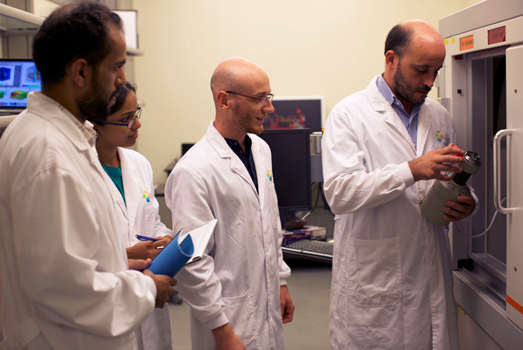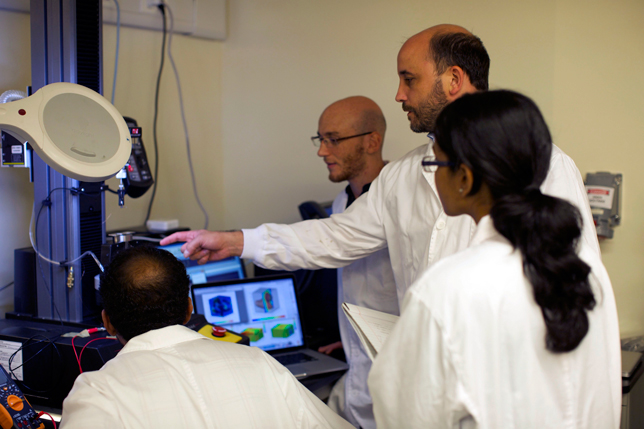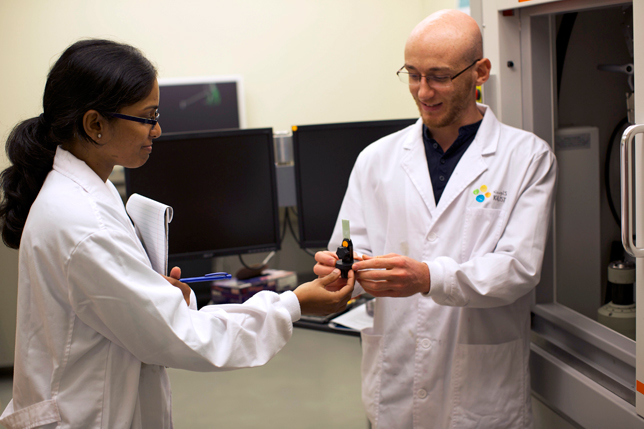Turning today's composite materials innovations into tomorrow's reality

(Left to right): Khaled Almuhammadi (Aramco engineer sponsored by Aramco for PhD degree at Kaust), Lakshmi Selvakumaran (PhD student), Ali Moussawi (PhD student), and Prof. Gilles Lubineau.
As sustainability has increasingly become a central focus in many sectors of the global economy, manufacturers are constantly striving to increase efficiency in terms of energy, weight, emissions and generally reducing their environmental footprint. Those requirements are the primary drivers behind the widespread adoption of composite materials.
Composite "materials" are created when two or more different materials are arranged together according to a microstructure (i.e. the way these materials are arranged together in space). The properties at large scale are intimately related to this microstructure. In other words, starting from the same raw materials but engineering different microstructures can result in completely different behaviors.
That makes this field full of opportunities for optimizing and tailoring the material to the application. When not only the mechanical behavior is considered, but multiple physics together (thermal, electrical) as well as the coupling between them, such materials can be engineered to obtain the complex behaviors needed for achieving multifunctional structures.
Composites are found in sports equipment, buildings, aircraft manufacturing, and the energy sector to name a few. Latest generation composite aircraft, for instance, can have a gain of around 25% efficiency compared to the same metallic design. Composites pipes can be used to make water or oil transportation infrastructures insensitive to corrosion and to reduce the pollution of the conveyed product.
As most common composites make use of carbon, they are often referred as "black metal". They have of course nothing to do with more classical metallic materials, but this expression well stresses the potential of these materials to become the most popular candidates for large-scale engineering. Yet, we are only at the beginning of the "black metal" revolution.
"Today we are very good at making composite structures; the main problem is how they are going to evolve in time," says Gilles Lubineau, Associate Professor of Mechanical Engineering at KAUST and Principal Investigator of the Composite and Heterogeneous Materials Analysis and Simulation Laboratory (COHMAS). That means it's possible to employ innovative composite structure technology to manufacture versatile aircrafts, windmill blades, and industrial pipes -- but the big question is ensuring their "stability and service lifetime."

Prof. Gilles Lubineau working with his PhD students.
Prof. Lubineau and his group's research thrust essentially focuses on computational modeling and experimental developments to tackle complex problems related to composite engineering. In the group, new materials are developed to meet new challenging operational conditions, techniques are being developed to understand their behavior, monitor their integrity, and computational approaches are being put in place to make possible the prediction of the relations between microstructure, functionality and durability.
Optimizing the microstructure to achieve the best performance
Successfully capturing the structural properties and optimal functionality of composite and heterogeneous materials requires a multi-faceted set of skills. The COHMAS team is split 50 percent with experts in computational mechanics while the other 50 percent has an expertise in experimental mechanics.
One of the particularities of Professor Lubineau's team, part of the mechanical engineering program and specializing in a wide variety of composite materials, is to bring together people with very different backgrounds, ranging from mechanical engineering, applied mathematics, and theoretical mechanics to material science and chemical engineering.
"This wide variety of background makes the team able to tackle real composite problems that are necessarily multiphysics and multiscale problems. This also makes the team capable of theoretically designing the microstructure to reach the best performance, and then to synthesize it and explore it from the experimental point of view; this ability is quite rare in a single group," Prof. Lubineau says.
The background of the team being primarily Mechanical Engineering and not Material Science, "we look at the material more from a structural point of view and this completely changes the approach" as Lubineau explains. The COHMAS team sees the material as a structure or as something that is part of a structure.
For illustration purposes, Prof. Lubineau takes the example of an aircraft: "The stresses, strains and everything is very heterogeneous. So it becomes necessary to accommodate the gradients in order to optimize materials at the critical locations in the aircraft's structure."
Doing so, Prof. Lubineau's group has recently design highly conductive polymer fibers with controlled conductivity and piezoresistivity. "Such fibers will help in creating new self sensing and multifunctional structures and fast-response heating components in wearable textiles. They are the building blocks for better functional integration which serves cost reduction, energy efficiency and improved conductivity in service," said Prof. Lubineau. "This has been made possible only by people with very different backgrounds working together towards a common goal".
Prof. Lubineau's group also works on composite materials destined for large industrial pipes, five or six meters in diameter, used for oil or water transportation. Particularly in arid regions like in Saudi Arabia, these pipes can experience high levels of degradation and specific aging conditions due to the extreme environmental conditions. Here again, understanding how the microstructure drives the final performance is key to process and design optimization.
Predicting and monitoring integrity
Material design is important, but understanding how the material is going to evolve in time is at least as crucial. A material might have tremendous properties, and be totally useless if these cannot be sustained at long term in a real working environment.
Among the multitude of factors that need to be considered are: mechanical degradation, aging, coupling with environments.

KAUST PhD students: Lakshmi Selvakumaran (left) and Ali Moussawi.
"You need to be able to predict what will happen in thirty years based on experiments that cannot last for more than a few weeks or a few months. What we want to achieve is more than a classical phenomenological model. We need models that can be use for making predictions with trust, models that can be use for design and exploration of new solutions," Lubineau said.
Predictive science, with a physics based description of experimental observations later formalized in rigorous models, is then essential to Prof. Lubineau's group. They have been engaged in designing models for many advanced structures while at Kaust, ranging from composite fuselage integrity to pipes integrity in sour environment.
Prof. Lubineau stresses that the objective is not to replace accelerated testing that is usually the preferred choice in industry (that means subjecting the structure to harsher condition during a shorter time to predict long term degradation).
"The objective of predictive testing is first, to design relevant accelerated testing conditions that are actually representative of what will happen at long term, and to understand the physics well enough to develop techniques for structural health monitoring (SHM)," said Prof. Lubineau.
"Monitoring composites is a real challenge today. Practical technologies are investigated to provide the most efficient and reliable real time monitoring such as optical fiber sensing (with Fiber Bragg Gratings) or electrical impedance/resistivity tomography (EIT/ERT). Thanks to these detection methods more challenging engineering may be envisaged through the design of preventive maintenance strategies." His team is then investigating how such reliable models can be used for better SHM techniques. Successes have already been met for impedance based monitoring for example.
Computational techniques for better design of Composite structures
A last axis of Prof. Lubineau's group is the design of adequate computational techniques to predict the integrity of complex structures such as composite made structures.
Prediction of crack propagation in such complex media is particularly challenging. Yet, this is a real industrial need.
"A crack is first of all a discontinuity, and continuum mechanics does not like discontinuities. It makes simulations much more complex and sometimes intractable with current technologies when many of them are involved," said Prof. Lubineau.
He developed with Boeing a successful technique called "morphing", published in Journal of the Mechanics and Physics of Solids, in which non-local continuum mechanics can be efficiently glued with classical continuum mechanics. "This provides a natural framework for computing crack nucleation and extension. This is still in its infancy, but we believe a promising technique in the future" adds Prof. Lubineau
Collaborations with Industry
Most of Prof. Lubineau's research at COHMAS is done in close collaboration with major industrial partners such as Boeing, Sabic, Aramco or Amiantit. The applied research and advanced theoretical concepts are directly tested and applied to concrete problems.
Despite the variety of these projects, they are all related to the application of advanced composite material to some real application such as composite fuselage, composite pipes, composites for civil engineering or the automotive industry. The team helps in bridging the gap between theoretical knowledge and the real application of these materials.
Saudi Arabia is already a major player as a provider of the raw products. But Prof. Lubineau foresees an expanded future role for the Kingdom where, instead of just selling the raw material, Saudi Arabia could directly sell technologies with the more advanced derived material at a much higher added value. "This can really play a role in developing the local economy."
By Meres J. Weche, KAUST News

